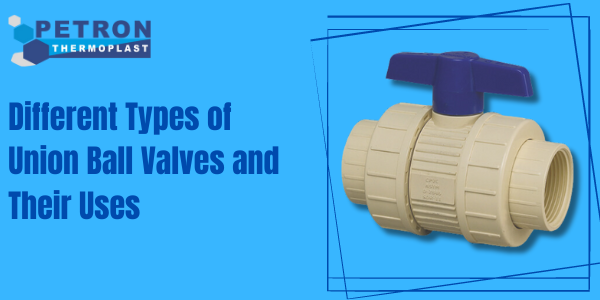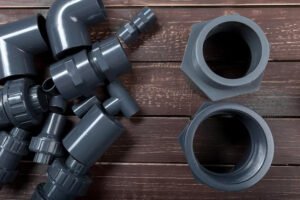In the intricate world of fluid control and regulation, the significance of valves cannot be overstated. Among the myriad types of valves available, Union Ball Valves stand out as versatile and efficient components. These valves find applications across various industries, owing to their design and functionality. In this comprehensive exploration, we delve into the nuances of different types of Union Ball Valves and their diverse uses.
Table of Contents
ToggleUnderstanding the Basics: What Sets Union Ball Valves Apart?
Union Ball Valves are a subset of ball valves, which are crucial for controlling the flow of liquids or gases. The distinguishing feature of a Union Ball Valve lies in its construction, specifically the presence of union connections. These unions allow for easy installation and removal of the valve without disturbing the entire pipeline.
Types of Union Ball Valves:
- Two-Piece Union Ball Valves:
The two-piece design is characterized by a body consisting of two main parts, connected by a central union. This construction facilitates straightforward disassembly for maintenance or replacement. The simplicity of the design enhances the valve’s reliability and ease of use. - Three-Piece Union Ball Valves:
In contrast, the three-piece Union Ball Valve comprises three separate components: a central body and two end caps. This design allows for even greater accessibility during maintenance, as the valve can be entirely disassembled. The inherent modularity of three-piece valves makes them highly adaptable to diverse applications. - Flanged Union Ball Valves:
For applications requiring a more robust connection to the pipeline, flanged Union Ball Valves come into play. These valves feature flanges on either end, providing a secure and durable attachment to the piping system. The flanged design is particularly beneficial in high-pressure environments. - Threaded Union Ball Valves:
When it comes to ease of installation, threaded Union Ball Valves take the spotlight. These valves have threaded ends, allowing for a quick and secure connection to threaded pipes or fittings. This feature simplifies the assembly process, making threaded Union Ball Valves a popular choice in various industries.
Material Matters: PVC Pipe Plastic in Union Ball Valves
The choice of materials in valve construction plays a pivotal role in determining their performance and longevity. One notable material finding extensive use in Union Ball Valves is PVC Pipe Plastic. This resilient material offers several advantages, making it a preferred choice in specific applications.
- Durability and Corrosion Resistance:
PVC Pipe Plastic is renowned for its durability and resistance to corrosion. This makes it an ideal choice for Union Ball Valves used in environments where exposure to corrosive substances is a concern. The material’s longevity contributes to the overall reliability of the valve. - Chemical Inertness:
Industries dealing with a variety of chemicals seek valves that do not react with the substances they control. PVC Pipe Plastic exhibits chemical inertness, ensuring that the valve remains unaffected by the fluids passing through it. This property is particularly valuable in chemical processing and similar applications. - Lightweight Construction:
Unlike metal valves, those constructed from PVC Pipe Plastic are notably lightweight. This characteristic simplifies handling during installation and maintenance. The reduced weight is especially advantageous in situations where portability and ease of maneuverability are essential.
Applications Across Industries: Varied Uses of Union Ball Valves
The adaptability of Union Ball Valves extends their usage across a multitude of industries. Understanding the specific applications within each sector provides insights into the versatility of these valves.
- Water Treatment Plants:
In water treatment plants, where precise control of fluid flow is paramount, Union Ball Valves find applications in regulating the movement of water through various stages of the treatment process. The ability to disassemble the valve for cleaning or repair enhances its utility in this context. - Chemical Processing:
The chemical industry relies on valves that can withstand the corrosive nature of many substances. Union Ball Valves constructed with corrosion-resistant materials, such as PVC Pipe Plastic, are integral in controlling the flow of chemicals through pipelines. - Oil and Gas Industry:
In the oil and gas sector, where harsh conditions and high pressures prevail, Union Ball Valves with flanged connections are often employed. These valves provide a robust and secure seal, ensuring reliable performance even in challenging environments. - Industrial Manufacturing:
The modularity of three-piece Union Ball Valves makes them suitable for diverse applications in industrial manufacturing. Whether controlling the flow of fluids in production processes or facilitating maintenance tasks, these valves offer flexibility and efficiency. - HVAC Systems:
Heating, ventilation, and air conditioning (HVAC) systems require precise control over the circulation of air and fluids. Threaded Union Ball Valves are commonly used in these applications, providing a convenient and reliable solution for regulating flow.
Maintenance and Care: Prolonging the Lifespan of Union Ball Valves
To ensure the continued reliability and efficiency of Union Ball Valves, a proactive approach to maintenance is essential. Regular inspections and proper care can prevent issues and extend the lifespan of these critical components.
- Routine Inspections:
Periodic inspections of Union Ball Valves help identify any signs of wear, leakage, or other potential issues. This proactive approach allows for timely repairs or replacements, minimizing downtime and ensuring uninterrupted operations. - Lubrication:
The smooth operation of a Union Ball Valve relies on the proper lubrication of its moving parts. Applying a suitable lubricant during maintenance intervals enhances the valve’s performance and reduces friction, contributing to its longevity. - Seal Replacement:
The integrity of the valve’s seals is crucial for preventing leaks. Regularly checking and, if necessary, replacing seals is a preventive measure that safeguards against potential leaks, maintaining the efficiency of the Union Ball Valve. - Cleaning Procedures:
Depending on the nature of the fluids passing through the valve, cleaning may be required at regular intervals. Disassembling the valve for thorough cleaning ensures that any accumulated debris or contaminants are removed, preventing operational issues.
Future Trends and Innovations in Union Ball Valve Technology
As technology advances, the field of valve manufacturing undergoes continuous evolution. Several trends and innovations are shaping the future of Union Ball Valves, introducing enhanced features and capabilities.
- Smart Valve Technology:
The integration of smart technologies into valve systems is gaining momentum. Smart Union Ball Valves equipped with sensors and connectivity features enable remote monitoring and control, enhancing efficiency and reducing the need for manual intervention. - Advanced Materials and Coatings:
Ongoing research in materials science is leading to the development of advanced materials and coatings for valves. These innovations aim to improve durability, resistance to extreme conditions, and overall performance, further expanding the applicability of Union Ball Valves. - Environmental Considerations:
The focus on environmental sustainability is influencing valve design and manufacturing. Manufacturers are exploring eco-friendly materials and processes, aligning with the global shift towards more sustainable and responsible industrial practices.
Conclusion: The Ever-Evolving Landscape of Union Ball Valves
In conclusion, the realm of Union Ball Valves is characterized by diversity, adaptability, and continuous innovation. From the simplicity of two-piece designs to the modularity of three-piece valves, each type serves specific purposes across various industries. The incorporation of PVC Pipe Plastic adds a layer of durability and chemical resistance, expanding the scope of applications.
As industries evolve and technology progresses, the future promises even more sophisticated Union Ball Valve solutions. Smart technologies, advanced materials, and a commitment to environmental responsibility are driving forces shaping the landscape of fluid control systems. Whether in water treatment plants, chemical processing facilities, or HVAC systems, the role of Union Ball Valves remains pivotal in ensuring the smooth and precise regulation of fluid flow.
You May Also Like : PVC 3-Way Ball Valve Installation Guide From Petron Thermoplast
Why Are Ball Valve Made Of Stainless Steel
Follow Us On : Facebook, LinkedIn





